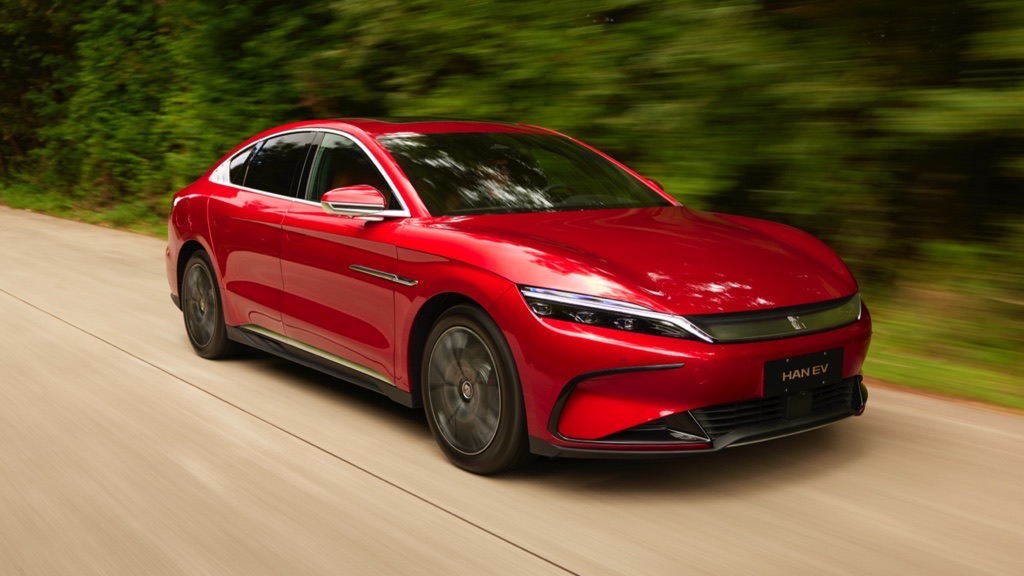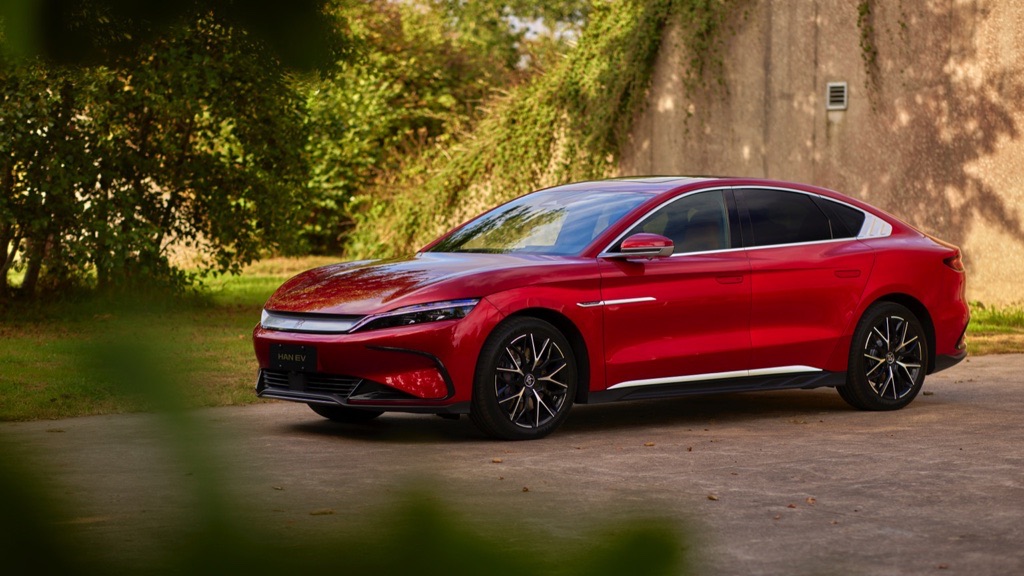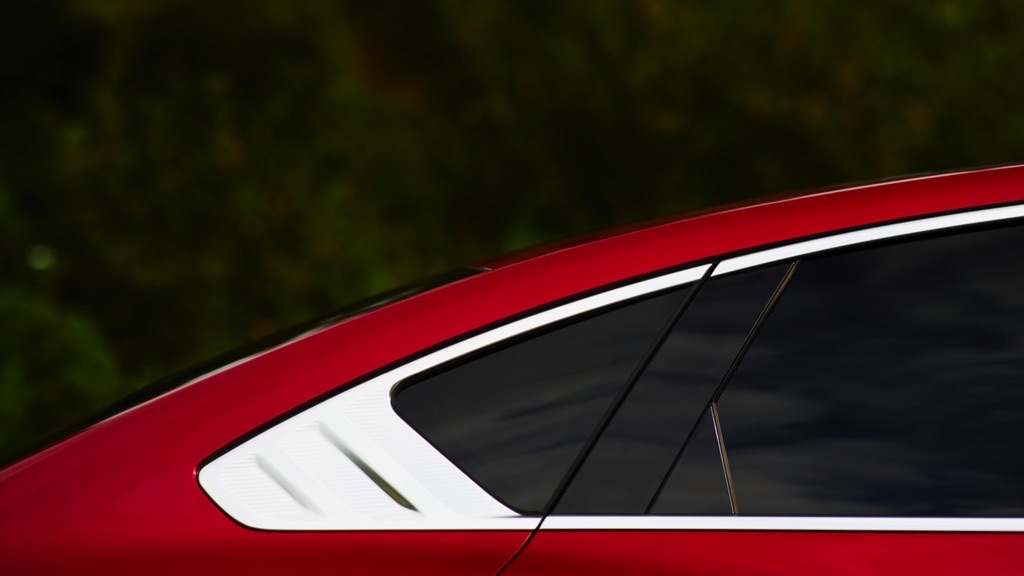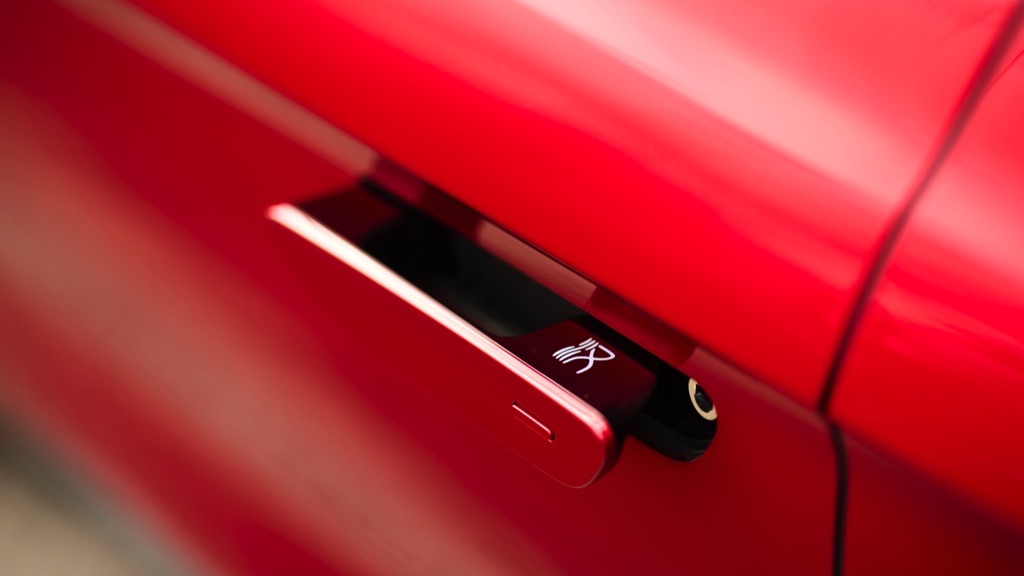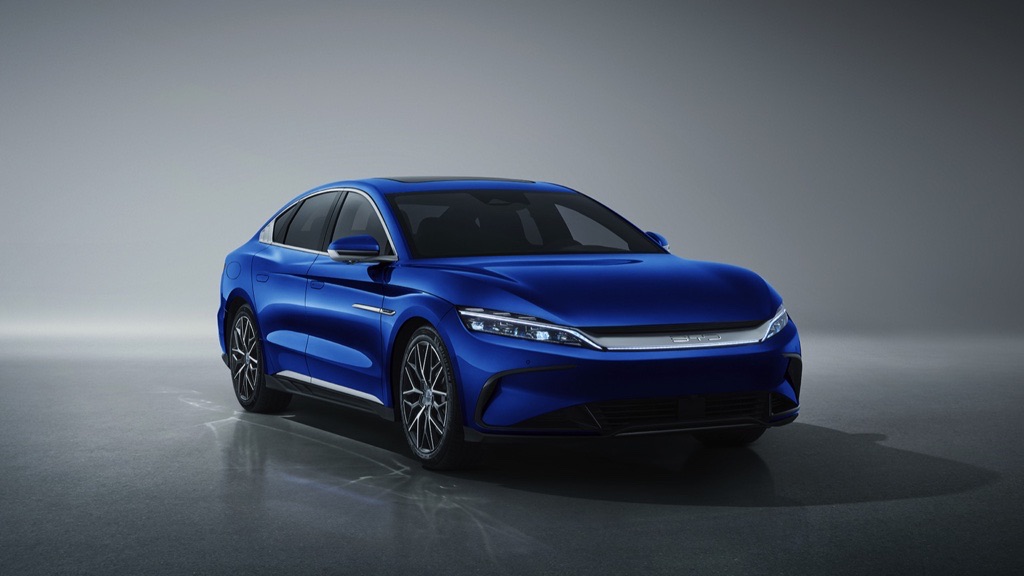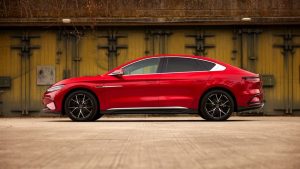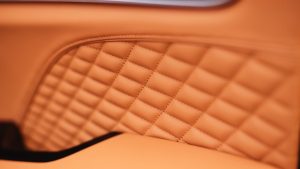The BYD HAN is an impressive all-electric sedan that combines luxurious styling, advanced technology, and exceptional performance. With its sleek design and innovative features, the BYD HAN represents BYD’s commitment to delivering high-quality electric vehicles. Here is a detailed description of the car along with its technical specifications:

Interior:
Inside the BYD HAN, you’ll find a spacious and well-crafted cabin that blends comfort and sophistication. The interior features premium materials, including high-quality upholstery and trim, creating an upscale atmosphere. The BYD HAN offers ample legroom and seating for up to five passengers, ensuring a comfortable ride for everyone.
Electric Powertrain:
The BYD HAN is powered by an advanced electric powertrain developed by BYD BYD. It typically includes a high-capacity battery pack, coupled with a powerful electric motor. The specifics of the powertrain may vary depending on the model and configuration, but the BYD HAN is known for its impressive acceleration, providing a thrilling driving experience.
Battery and Range:
The BYD HAN is equipped with a large-capacity lithium-ion battery pack, which offers an impressive electric range. The exact range may vary depending on the battery size and driving conditions. With its extended range, the BYD HAN provides the freedom to embark on longer journeys with fewer charging stops.
Charging Capabilities:
The BYD HAN supports various charging options, allowing for convenient recharging. It can be charged using standard AC outlets, but for faster charging, the BYD HAN is compatible with DC fast chargers. With a compatible fast charger, the BYD HAN can be charged to a significant level in a relatively short time, providing added convenience for busy lifestyles.
Technology and Features:
The BYD HAN incorporates advanced technology and features to enhance the driving experience. It typically includes a cutting-edge infotainment system with a large touchscreen display, offering seamless connectivity and access to various multimedia and navigation functions. Additionally, the BYD HAN may come equipped with advanced driver-assistance systems, promoting safety and improving overall driving comfort.

While specific technical specifications of the BYD HAN may vary depending on the model and market, it represents a premium electric sedan that combines style, performance, and advanced technology. With its luxurious interior, impressive electric range, and innovative features, the BYD HAN is a compelling choice for those seeking an electric vehicle that offers both comfort and exhilarating performance.
| Performance | |
| Acceleration 0 – 100 km/h | 3.9 sec |
| Top Speed | 180 km/h |
| Electric Range | 475 km |
| Total Power | 380 kW (517 PS) |
| Total Torque | 700 Nm |
| Drive | AWD |
| Battery | |
| Nominal Capacity | 88.0 kWh |
| Battery Type | Lithium-ion |
| Number of Cells | 178 |
| Architecture | 800 V |
| Useable Capacity | 85.4 kWh |
| Cathode Material | LFP |
| Pack Configuration | 178s1p |
| Nominal Voltage | 569 V |
| Charging | |
| Home / Destination | |
| Charge Port | Type 2 |
| Port Location | Right Side – Rear |
| Charge Power | 6.6 kW AC |
| Charge Time (0->475 km) | 15h15m |
| Charge Speed | 31 km/h |
| Fast Charging | |
| Fastcharge Port | CCS |
| FC Port Location | Right Side – Rear |
| Fastcharge Power (max) | 120 kW DC |
| Fastcharge Time (48->380 km) | 44 min |
| Fastcharge Speed | 450 km/h |
| Energy Consumption | |
| EVDB Real Range | |
| Range | 475 km |
| Vehicle Consumption | 180 Wh/km |
| CO2 Emissions | 0 g/km |
| Vehicle Fuel Equivalent | 2.0 l/100km |
| WLTP Ratings | |
| Range | 521 km |
| Rated Consumption | 185 Wh/km |
| Vehicle Consumption | 164 Wh/km |
| CO2 Emissions | 0 g/km |
| Rated Fuel Equivalent | 2.1 l/100km |
| Vehicle Fuel Equivalent | 1.8 l/100km |
| Dimensions and Weight | |
| Length | 4995 mm |
| Width | 1910 mm |
| Width with mirrors | 2134 mm |
| Height | 1495 mm |
| Wheelbase | 2920 mm |
| Weight Unladen (EU) | 2325 kg |
| Gross Vehicle Weight (GVWR) | 2660 kg |
| Max. Payload | 410 kg |
| Cargo Volume | 410 L |
| Cargo Volume Max | No Data |
| Cargo Volume Frunk | 0 L |
| Roof Load | 0 kg |
| Tow Hitch Possible | No |
| Towing Weight Unbraked | 0 kg |
| Towing Weight Braked | 0 kg |
| Vertical Load Max | 0 kg |
| Miscellaneous | |
| Seats | 5 people |
| Isofix | Yes, 2 seats |
| Turning Circle | 12.3 m |
| Platform | No Data |
| EV Dedicated Platform | No Data |
| Car Body | Sedan |
| Segment | E – Executive |
| Roof Rails | No |
| Heat pump (HP) | Yes |
| HP Standard Equipment | Yes |
Home And Destination Charging (0 -> 100%)
A public charging station is required to use the highest possible charging rate. The EVSE/charging station’s charging capacity affects how long it takes to fully charge the battery. The table below shows all possible options for fully charging the BYD HAN.
In Europe, plugging an electric car into an outlet is often as easy as plugging it into a household outlet, but there are differences from country to country. The table below shows the different ways to charge the BYD HAN, but in some countries, some chargers may not be available.
Type 2 (Mennekes – IEC 62196)

| Charging Point | Max. Power | Power | Time | Rate |
| Standard 6.6 kW On-Board Charger | ||||
| Wall Plug (2.3 kW) | 230V / 1x10A | 2.3 kW | 43h45m | 11 km/h |
| 1-phase 16A (3.7 kW) | 230V / 1x16A | 3.7 kW | 27h15m | 17 km/h |
| 1-phase 32A (7.4 kW) | 230V / 1x29A | 6.6 kW | 15h15m | 31 km/h |
| 3-phase 16A (11 kW) | 230V / 1x16A | 3.7 kW | 27h15m | 17 km/h |
| 3-phase 32A (22 kW) | 230V / 1x29A | 6.6 kW | 15h15m | 31 km/h |
| Optional 7.4kW On-Board Charger | ||||
| Wall Plug (2.3 kW) | 230V / 1x10A | 2.3 kW | 43h45m | 11 km/h |
| 1-phase 16A (3.7 kW) | 230V / 1x16A | 3.7 kW | 27h15m | 17 km/h |
| 1-phase 32A (7.4 kW) | 230V / 1x32A | 7.4 kW | 13h45m | 35 km/h |
| 3-phase 16A (11 kW) | 230V / 1x16A | 3.7 kW | 27h15m | 17 km/h |
| 3-phase 32A (22 kW) | 230V / 1x32A | 7.4 kW | 13h45m | 35 km/h |
Fast Charging (10 -> 80%)
If you want to enjoy driving an electric car, one of the most important features to consider is the number of miles per hour the car can travel while charged. This is called the “range” of the car. All electric cars have a certain range, even if they are 100% charged. This is because they do not have an internal combustion engine to lean on if you need to drive a long distance.
Max. Power: The maximum power provided by the charging point
Avg. Power: The average power provided by the charging point during a session of 10% to 80%.
Time: the time it takes to charge from 10% to 80%
Speed: the average charging rate during the session of 10% to 80%
Combined Charging System (CCS Combo 2)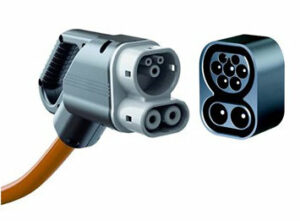
| Charging Point | Max. Power | Avg. Power | Time | Rate |
| CCS (50 kW DC) | 50 kW | 40 kW | 94 min | 210 km/h |
| CCS (100 kW DC) | 100 kW | 75 kW | 50 min | 390 km/h |
| CCS (150 kW DC) | 120 kW | 85 kW | 44 min | 450 km/h |
| Brand | BYD |
| Model | HAN |
| Body Style | Sedan |
| Car Engine | 700 |
| Motor power | 380 |
| Maximum Torque, Nm | 700 |
| Battery Energy, kWh | 88.0 |
| Power reserve (NEDC/EPA/WLTP), km | - / - / 475 |
| Level Charging (230/400/DC), hours | 43.45 / 13.45 / 0.44 |
| Electrical Acceleration, 0-100 km/h (0-62.1 mph) in sec | 3.9 |
| Top Speed, km/h | 180 |
